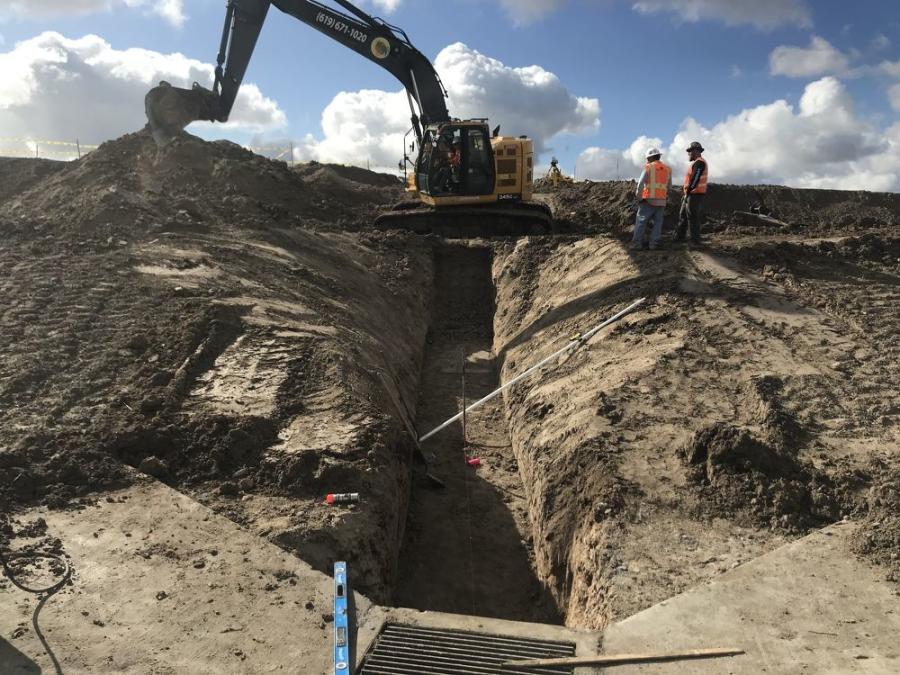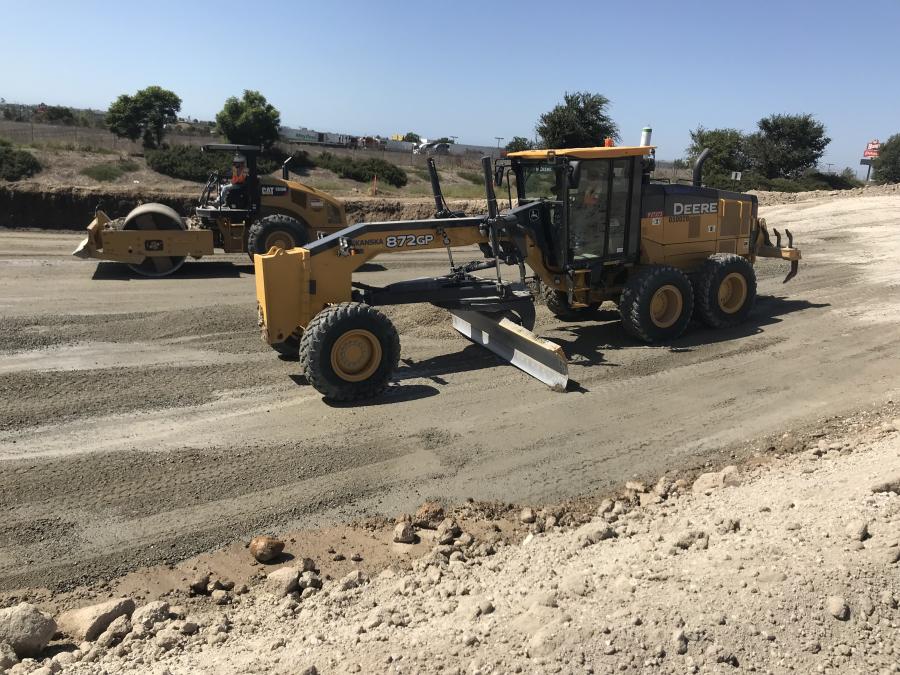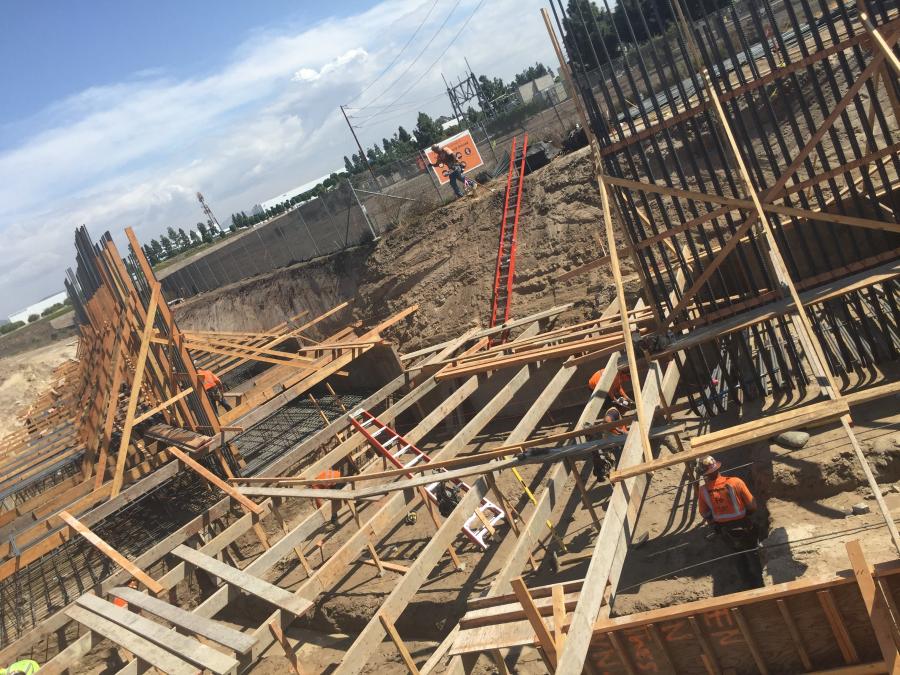Nearly 26,000 linear ft. of storm water pipe are being installed for the project. Here, a section of the site is being prepared.
As part of the California Department of Transportation (Caltrans) and San Diego Association of Governments (SANDAG) state Route 11 (SR-11)/Otay Mesa East Port of Entry project, crews from Skanska US Civil are constructing the final segment of the future toll road SR-11 and the southbound connector ramps, linking southbound State Route 125 (SR-125) to eastbound SR-11 and eastbound state Route 905 (SR-905).
The project is a joint-venture between Caltrans and SANDAG, in collaboration with state and federal partners in the U.S and Mexico, to create a 21st century port of entry that will enhance regional mobility, reduce greenhouse gas emissions, fuel economic growth, and bolster bi-national trade.
Construction began on Skanska's contract ($103M) began in July 2019 and will be completed August 2021.
With recent approval by the United States- Mexico-Canada Agreement by the U.S. and Mexican governments to replace the North American Free Trade Agreement, the need for modern border facilities to enhance trade is all the more paramount.
"The new port of entry will be clean, green, and smart," states the project web page. "Reducing vehicle wait times and building in smart technologies will help reduce emissions and improve air quality in the border region. As the U.S.-Mexico border region grows, there is a need to improve the commercial movement of goods, services, and passengers through an efficient, integrated system to bolster the local, state, federal, and international economies."
In 2018, the nearby Otay Mesa and Tecate ports of entry processed a combined $47.5 billion in total bilateral trade, and that number is expected to increase over the coming years. The project planners stress that this new border crossing will facilitate job growth and new economic opportunities for private sectors on both sides of the border.
Roadway and connecter ramp construction currently underway will ultimately provide a direct connection to the new Otay Mesa East Port of Entry and a California Highway Patrol Commercial Vehicle Enforcement Facility, helping to enable fast, predictable, and secure border crossings.
Since construction began last summer, crews have focused their efforts on building 1.2 new mi. of SR-11 and setting up falsework for the construction of the two connector bridges at the SR-11/SR-905/SR-125 interchange. This work includes roadway and connecter ramp construction, earth work, site preparation, and drainage infrastructure installation.
The infrastructure for the Skanska contract was designed by Caltrans.
Six bridges (cast-in-place box tube girder types) are being constructed for the interchange — two connector and four smaller underpass ones and the paving of SR-11 (east-west) that will connect with the new POE, three lanes in direction, will start in October and be finished in March 2021.
Chuck Girten, Skanska's senior project manager, has overseen many large projects.
With the completed portion of the new road not open to traffic and the section of the new road being constructed on a green field, Skanska crews have plenty of open space to work and a dedicated route to bring in new materials and equipment and remove excavated materials.
Most of the work is being done by day, with limited night work to occur at the interchange for the falsework installation.
"There have been minimal challenges on this project because we are on a new alignment, one of the last new alignments in the region," said Girten. "As part of the Caltrans Partnership Program, we have meetings every quarter and have implemented a resolution ladder where we work together to resolve everything at the lowest level. If it can't be resolved there, it's elevated to the superintendent and senior inspector."
One million yds. of the 1.2 million yds. of earth work has been completed thus far. About 500,000 yds. were hauled in legal haul trucks, loaded by excavator, to be used at the intersection site. Another 500,000 yds. were moved at the road site with a fleet of 10 Cat 637 scrapers.
"We have GPS installed on our dozers and motor graders that are putting the fill in and finishing as we go," said Girten. "Everything on this job has been cut to fill embankment — there is no borrow or need to import."
The excavation is anticipated to be completed in spring of this year.
Utility installation for SR 11 consists of fiber optics for Caltrans traffic management system, electrical lines for street lighting, and 26,000 linear ft. of storm drain pipe.
"To date we've installed about 10,000 linear feet in various sizes from 60 inch down to 18 inch," said Girten. "We have 1,000 feet of cast-in-place double (seven-by-seven) box culvert There are no challenges at all — it's being installed alongside the future roadway."
There is plenty of space to store the prefabricated concrete pipe.
Multiple crews will be dedicated to the paving, with the eastbound lanes to be paved first and then have them turn around to pave the westbound lanes.
"We can pour concrete by day as we won't be impacted by the hot summer temperatures," said Girten. "We will have a batch plant on site to produce the concrete. We are also crushing rubble and recycling it to make all of our Class II products."
Another sustainable aspect of the project is that the off-road construction equipment is being fueled by renewable diesel fuel — plant-based and produced by refineries that convert grease collected from restaurants into fuel.
"The fuel has no impacts on our equipment and it's about the same price as regular diesel fuel," said Girten, "and it meets Tier Four emissions with all the new equipment."
One unique aspect of this project is the inclusion of a divergent diamond interchange, one of the first to be built in California. There are two connector bridges at the interchange, one that will connect southbound SR 125 to eastbound SR 11 and the other will connect southbound SR 125 to eastbound SR 905.
The construction of the divergent diamond will require road closures.
"We have our own subcontractor to control traffic," said Girten. "We follow Caltrans charts for lane closures as far as times and days when they can be closed. From April 2020 to April 2021, we are closing the Enrico Fermi Drive overcross so we can build a new bridge. The location provides good access to the work site and space to store materials and equipment."
The intersection will require 15,000 cu. yds. of structural concrete and approximately nine million lbs. of falsework steel for the bridges.
The new road is based on a 2-ft. deep subbase that will require 300,000 tons of Class II base to be covered with 5 in. of asphalt, and topped by 10 in. of concrete pavement that will require 45,000 cu. yds. of concrete pavement.
The Skanska team is united in its drive to complete the project.
"We have an excellent team and we're all in this together," said Girten. "We're a union contractor and our crafts people are very talented. We're very fortunate to get the crews that we have."
Peak days have around 135 Skanska and subcontractor employees on site, with the major subcontractors including one for iron work, one for electrical, and another for concrete and asphalt.
For this project, Skanska purchased new Cat excavators — 349s and 336s — from Hawthorne Cat and John Deere 872 motor graders with GPS from RDO Equipment Company.
Also being used are one crawler and three mobile cranes, and numerous pieces of support equipment such as compactors, loaders, forklifts, and mobile aerial work platforms.
"Most of the wear and tear issues so far deal with ground engaging — ripper tips and bucket teeth," said Girten. "We've not had much as far as repairs. The key to our up-time and availability of equipment is our operators completing their daily inspections and walk-arounds and communicating to the maintenance team and myself for what needs to be fixed so we can stay on top it."
Skanska has an onsite mechanic and an oiler to look after the equipment at both sites.
In the California area, Skanska also purchases and rents equipment from local dealerships.
"Communications is the key to our planning effort," said Girten. "It helps the dealers support us — not last minute put-out-the-fire kind of stuff. Our superintendents and engineers do an exceptional job assigning the work and knowing what equipment is needed and when. We try to utilize Skanska-owned equipment first from other projects so we can minimize the equipment that is needed and then we go to the dealers for short-term rentals as our needs arise."
Girten has 34 years of experience in the construction industry.
"The pre-planning in the early stages of this job is what made it a success right now," he said. "Planning for safety into production doesn't cost any more money and in fact, it makes you more efficient."
Today's top stories

































